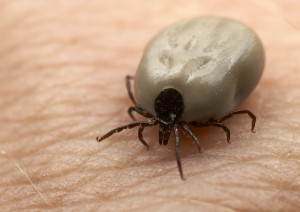Backpacking Safety in Deer Tick Country
Almost all beautiful, backcountry destinations in North America have two things in common: breathtaking scenery and the unfortunate potential to harbor some member of the tick family. One specific tick species, Ixodes  pacificus, commonly known as the deer tick, has drawn much attention in recent years due to its role in introducing Lyme disease to the human population. While the potential for a close encounter with a deer tick should not be a deterrent to frequenting the wilderness areas of this beautiful country, some precautions will ensure as little exposure as possible to the ill effects of tick-borne diseases.
pacificus, commonly known as the deer tick, has drawn much attention in recent years due to its role in introducing Lyme disease to the human population. While the potential for a close encounter with a deer tick should not be a deterrent to frequenting the wilderness areas of this beautiful country, some precautions will ensure as little exposure as possible to the ill effects of tick-borne diseases.
The ability to identify deer ticks and their preferred habitat is the first step in self-protection. An adult female deer tick is about the size of a sesame seed with a black and reddish brown body and legs. An adult male is dark brown and a little smaller. Younger, immature ticks at the egg and larva stages are very difficult to identify and are incapable of transmitting Lyme disease. Transmission is not effective until the nymph and reproductive adult phases when the ticks are also larger and easier to recognize.
Lyme disease tends to be prevalent in, or endemic to, specific geographical areas. Named after the town in Connecticut where it made its national debut in a group of young human hosts, Lyme disease has slowly spread to other parts of the country, although the majority of cases are still specific to the northeastern United States. Deer ticks prefer heavily wooded forests or areas of dense brush that are populated by their favorite hosts, deer and rodents. This ideal habitat is found throughout the eastern and central United States with some deer tick activity also being detected in the western states.
Before you head out to your backpacking or camping spot, a call to the Forest Service or the National Park that is closest to your destination will tell you whether or not deer ticks have been a known problem in that area. Regardless of whether their presence has been established, however, it is advisable to take some further steps to avoid contact with ticks of any kind that may share the wilderness with you.
Physical barrier methods are the safest form of protection. Wearing long sleeves and long pants makes your skin unavailable and harder to access and tucking your pants into your boots or socks helps narrow that access even further. Pinning up long hair or wearing a hat will provide even fewer opportunities and surfaces for ticks to grab onto. There is some evidence to suggest that ticks are attracted to darker colors and wearing light colored clothing will also make ticks easier to see and remove.
The Department of Defense has enacted a repellant system that they have found to be the most effective form of protection against tick bite. The D.O.D. system uses two recognized topical repellents together, DEET and permethrin, on skin and clothing respectively. While both products are extremely powerful deterrents, they are also extremely toxic, with permethrin being unsuitable for use on human skin. Because these chemical agents can be absorbed through the skin, great care should be taken in their use and should only be employed when absolutely necessary, or when the potential for harm from tick exposure outweighs the risks inherent in chemical repellents. Many natural herbs, essences and oils act as deterrents to ticks and other insects and present no toxicity whatsoever.
Actual transmission of Lyme bacteria from an infected tick to its host requires about 24 hours of attachment. It is very important, therefore, to check thoroughly after outings into risk areas to remove any ticks present before they have a chance to attach and cause problems. This is probably the single most prudent practice of all the preventive measures and needs to be done whether repellents are used or not. If an attached tick is discovered, it should be removed as quickly as possible, being careful to pull it straight out with tweezers or by hand, leaving no body parts behind.
There is no need to let deer ticks ruin your backpacking plans. These simple, proactive measures coupled with a watchful eye will ensure peace of mind and a great time in the spectacular outdoors.
